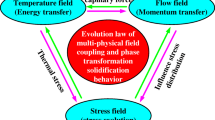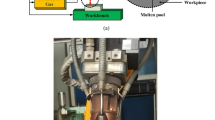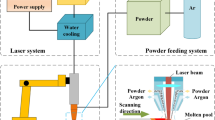Abstract
During the laser cladding process, the flow rate and direction of the molten metal significantly affect the shape of the molten pool and the solidification process. The addition of active elements to the molten pool will change the temperature coefficient of surface tension, causing variations of the Marangoni convection in the molten pool to affect the flow, solidification of molten metal, and the molten pool formation. It is difficult to track the transient evolution of the molten pool in real time by the experimental method, and the numerical simulation can effectively reveal the evolution mechanism of the multi-field coupling in the cladding process. In this study, the thermophysical parameters of the material were calculated by the CALPHAD method, and a multi-field coupling three-dimensional numerical model of Fe60 cladding by a disk laser is established. The transient evolution behavior of the temperature, flow, and stress field during the cladding process was analyzed, and the effect of sulfur element on the heat transfer and convection behavior of the molten pool was revealed. The calculation shows that sulfur element has little effect on the temperature field and stress field. In the molten pool without sulfur, the molten metal flows from the center to the edge of the molten pool to form a “double-eddy like” Marangoni convection. When adding sulfur to the molten pool, the direction of Marangoni convection changes and the molten pool is deeper. With the increase of sulfur content, the flow rate of molten pool increases gradually.






















Similar content being viewed by others
Data availability
The authors confirm that the data supporting the findings of this study are available within the article.
References
Bayat M, Dong W, Thorbrog J et al (2021) A review of multi-scale and multi-physics simulations of metal additive manufacturing processes with focus on modeling strategies. Addit Manuf 47. https://doi.org/10.1016/j.addma.2021.102278
Li C, Liu C, Li S et al (2019) Numerical simulation of thermal evolution and solidification behavior of laser cladding AlSiTiNi composite coatings. Coatings 9(6):391. https://doi.org/10.3390/coatings9060391
Chen L, Yu T, Xu P et al (2021) In-situ NbC reinforced Fe-based coating by laser cladding: simulation and experiment[J]. Surface and Coatings Technology 127027. https://doi.org/10.1016/j.surfcoat.2021.127027
Wu Z, Li T, Li Q et al (2019) Process optimization of laser cladding Ni60A alloy coating in remanufacturing. Opt Laser Technol 120:105718. https://doi.org/10.1016/j.optlastec.2019.105718
Gu Z, Mao P, Gou Y et al (2020) Microstructure and properties of MgMoNbFeTi2Yx high entropy alloy coatings by laser cladding. Surface and Coatings Technology 126303. https://doi.org/10.1016/j.surfcoat.2020.126303
Kumar A, Roy S (2009) Effect of three-dimensional melt pool convection on process characteristics during laser cladding. Comput Mater Sci 46(2):495–506. https://doi.org/10.1016/j.commatsci.2009.04.002
Zheng L, Jiao C, Lin Y et al (2016) Marangoni convection heat and mass transport of power-law fluid in porous medium with heat generation and chemical reaction. Heat Transfer Eng 38(5–8):641–652. https://doi.org/10.1080/01457632.2016.1200384
Nanjundappa C, Prakash H, Shivakumara I et al (2014) Effect of temperature dependent viscosity on the onset of Bénard-Marangoni ferroconvection. Int Commun Heat Mass Transf 51(FEB):25–30. https://doi.org/10.1016/j.icheatmasstransfer.2014.01.010
Wu H (2016) Well-posedness of a diffuse-interface model for two-phase incompressible flows with thermo-induced Marangoni effect. https://doi.org/10.1017/S0956792516000322
Starodubtsev Y, Tsepelev V (2021) Analysis of surface tension and viscosity of liquid metals[J]. Metall and Mater Trans B 52:1886–1890. https://doi.org/10.1007/s11663-021-02157-y
Ge H, Xu H, Wang J et al. Investigation on composition distribution of dissimilar laser cladding process using a three-phase model. International Journal of Heat and Mass Transfer, 170. https://doi.org/10.1016/j.ijheatmasstransfer.2021.120975
Gan Z, Liu H, Li S et al (2017) Modeling of thermal behavior and mass transport in multi-layer laser additive manufacturing of Ni-based alloy on cast iron. Int J Heat Mass Transf 111(Aug):709–722. https://doi.org/10.1016/j.ijheatmasstransfer.2017.04.055
Zhang Q, Xu P, Zha G et al (2021) Numerical simulations of temperature and stress field of Fe-Mn-Si-Cr-Ni shape memory alloy coating synthesized by laser cladding. Optik 242:167079. https://doi.org/10.1016/j.ijleo.2021.167079
Song B, Yu T, Jiang X et al. Evolution and convection mechanism of the melt pool formed by V-groove laser cladding. Optics Laser Technol, 144. https://doi.org/10.1016/j.optlastec.2021.107443
Shen C, Li C, Guo Y et al (2021) Modeling of temperature distribution and clad geometry of the molten pool during laser cladding of TiAlSi alloys[J]. Opt Laser Technol 142:107277. https://doi.org/10.1016/j.optlastec.2021.107277
Song B, Yu T, Jiang X et al. Development mechanism and solidification morphology of molten pool generated by laser cladding. Int J Therm Sci, 159. https://doi.org/10.1016/j.ijthermalsci.2020.106579
Li C, Zhang D, Gao X et al (2022) Numerical simulation method of the multi-field coupling mechanism for laser cladding 316L powder. Weld World 66(3):423–440. https://doi.org/10.1007/s40194-021-01213-0
Gan Z, Yu G, He X et al (2017) Surface-active element transport and its effect on liquid metal flow in laser-assisted additive manufacturing. Int Commun Heat Mass Transf 86(Aug):206–214. https://doi.org/10.1016/j.icheatmasstransfer.2017.06.007
Yang J, Aiyiti W, Jiang H et al (2021) Evolution of molten pool morphology and prediction of inclined cladding layer morphology. Opt Laser Technol 142:107164. https://doi.org/10.1016/j.optlastec.2021.107164
Song B, Yu T, Jiang X et al (2020) Effect of laser power on molten pool evolution and convection. Numer Heat Transf Appl 8:1–12. https://doi.org/10.1080/10407782.2020.1777795
Jing Y, Cheng Y, Zhang X et al. Simulation and experimental investigations on the effect of Marangoni convection on thermal field during laser cladding process. Optik, 203. https://doi.org/10.1016/j.ijleo.2019.164044
Kidess A, Kenjereš S, Kleijn C (2016) The influence of surfactants on thermocapillary flow instabilities in low Prandtl melting pools[J]. Phys Fluids 28(6):93–127. https://doi.org/10.1146/annurev.fluid.33.1.93
Xiu J, Li Y, Cheng Y (2017) Effects of stress concentration and residual stress on vibration fatigue behavior of socket weld[J]. Journal of Adhesion Science & Technology 1–15. https://doi.org/10.1080/01694243.2017.1355726
Liu H, Qin X, Wu M et al (2019) Numerical simulation of thermal and stress field of single track cladding in wide-beam laser cladding. Int J Adv Manuf Technol 104(9–12):3959–3976. https://doi.org/10.1007/s00170-019-04056-8
Xie Y, Zhuang J, Huang B et al (2020) Effect of different welding parameters on residual stress and deformation of 20/0Cr18Ni9 dissimilar metal arc-welding joint. J Adhes Sci Technol 34(6):1–25. https://doi.org/10.1080/01694243.2020.1715670
Yao F, Fang L (2021) Thermal stress cycle simulation in laser cladding process of Ni-based coating on H13 steel. Coatings 11(2):203. https://doi.org/10.3390/coatings11020203
Song J, Chew Y, Bi G et al (2018) Numerical and experimental study of laser aided additive manufacturing for melt-pool profile and grain orientation analysis-ScienceDirect. Mater Des 137:286–297. https://doi.org/10.1016/j.matdes.2017.10.033
Chen L, Zhao Y, Song B et al (2021) Modeling and simulation of 3D geometry prediction and dynamic solidification behavior of Fe-based coatings by laser cladding. Opt Laser Technol 139:107009. https://doi.org/10.1016/j.optlastec.2021.107009
Morville S, Carin M, Peyre P et al (2012) 2D longitudinal modeling of heat transfer and fluid flow during multilayered direct laser metal deposition process. J Laser Appl 24(3):1–9. https://doi.org/10.2351/1.4726445
Sahoo P, Debroy T, Mcnallan MJ (1998) Surface tension of binary metal-surface active solute systems under conditions relevant to welding metallurgy. Metall Trans B 19:483–491. https://doi.org/10.1007/BF02657748
Li C, Xu Y, Jia TH et al (2021) Numerical simulation research on multifield coupling evolution mechanism of IN625 laser cladding on nodular cast iron. Int J Adv Manuf Technol 119(9–10):5647–5669. https://doi.org/10.1007/s00170-021-08249-y
Zhang C, Miao J, Chen S et al (2019) CALPHAD-based modeling and experimental validation of microstructural evolution and microsegregation in magnesium alloys during solidification[J]. J Phase Equilib Diffus 40(4):495–507. https://doi.org/10.1007/s11669-019-00732-0
Funding
This work was supported by the Innovation Talent Support Plan Program of Higher Education Institutions of Liaoning Province (20201020).
Author information
Authors and Affiliations
Contributions
Tenghui Jia and Chang Li are responsible for manuscript writing, numerical simulation, and experimental work. Shuangliang Jia, Yunpeng Liu, and Xing Han contributed to data extraction and format correction of the article. All the authors read and approved the final manuscript.
Corresponding author
Ethics declarations
Ethical approval
Not applicable.
Consent to participate
Not applicable.
Consent to publish
Not applicable.
Competing interests
The authors declare no competing interests.
Additional information
Publisher's note
Springer Nature remains neutral with regard to jurisdictional claims in published maps and institutional affiliations.
Tenghui Jia and Chang Li are co-first authors of the article.
Rights and permissions
Springer Nature or its licensor (e.g. a society or other partner) holds exclusive rights to this article under a publishing agreement with the author(s) or other rightsholder(s); author self-archiving of the accepted manuscript version of this article is solely governed by the terms of such publishing agreement and applicable law.
About this article
Cite this article
Jia, T., Li, C., Jia, S. et al. Influence mechanism of active elements on multi-field coupling in laser cladding Fe60 process. Int J Adv Manuf Technol 124, 411–428 (2023). https://doi.org/10.1007/s00170-022-10518-3
Received:
Accepted:
Published:
Issue Date:
DOI: https://doi.org/10.1007/s00170-022-10518-3




